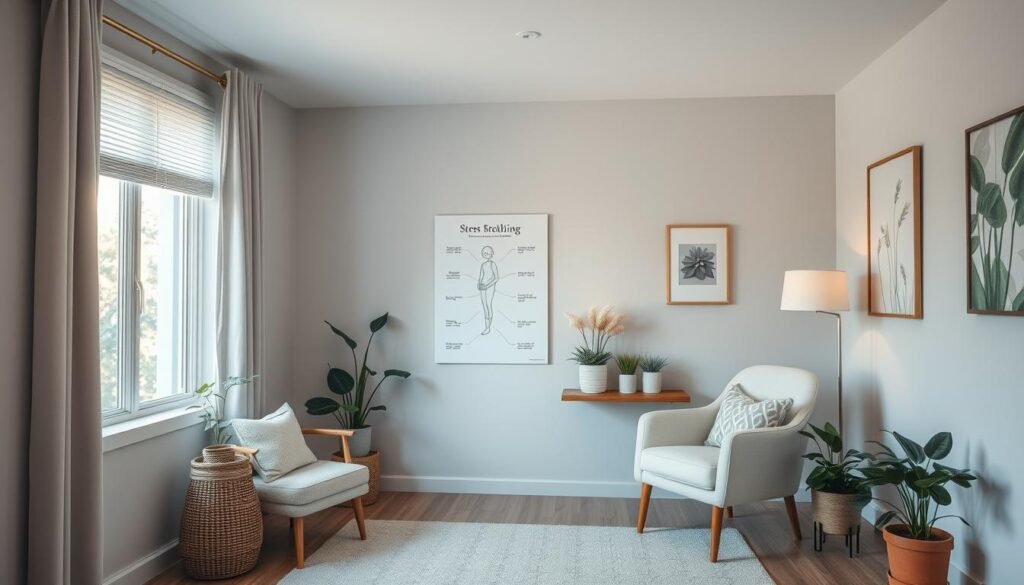Did you know about 30-50% of people with chronic heart failure feel short of breath? This is called chronic dyspnoea. It’s a big problem for many, especially those dealing with shortness of breath anxiety in their lives. Feelings of anxiety and panic can begin from not being able to breathe well. This article will look at why shortness of breath makes us anxious. We’ll talk about its causes and what it feels like. You’ll also learn how to cope through anxiety breathing techniques that help you feel better. With the right tools, you can take control again and improve your daily life.
Key Takeaways
- About 30-50% of chronic heart failure patients suffer from ongoing breathlessness.
- Shortness of breath can make anxiety worse, causing panic attacks in 60% of sufferers.
- Structured exercise programs can make 40-60% of breathless people feel better.
- Breathing exercises may lessen breathlessness for 30-50% of patients.
- Effective breathing methods can help calm “fight-or-flight” reactions in anxiety disorders.
Understanding Shortness of Breath and Anxiety
Shortness of breath, or dyspnea, is common in people with anxiety disorders. Between 60% to 90% of these individuals report feeling breathless during anxiety episodes. This is especially true during panic attacks, affecting around 30% of those with panic disorder.
People with generalized anxiety disorder (GAD) often feel this breathlessness too. Nearly 75% of them experience such physical symptoms. Breathlessness can worsen panic and distress, creating a cycle where anxiety and breathing problems feed off each other. In panic attacks, about 74-85% report dyspnea, greatly affecting their life and daily activities.
The body’s “fight or flight” response to anxiety changes how we breathe. Anxiety can make us breathe faster and tense up our chest muscles. It’s important to know the difference between anxiety-related breathlessness and that caused by medical conditions.
It’s crucial to understand what causes this shortness of breath to manage it better. Cognitive Behavioral Therapy (CBT) has been effective in treating anxiety and its physical symptoms, with a 60% to 75% success rate in studies. Relaxation techniques and mindfulness can also help, highlighting the need to care for both mental and physical health.
Knowing that breathlessness often goes hand in hand with anxiety disorders can push people to seek help. Although it’s challenging, many find relief through therapy, medications, and other supportive methods.
What Causes Shortness of Breath Anxiety?
Shortness of breath anxiety can come from many sources. Health issues like asthma and COPD are key reasons. Over 15 million Americans have asthma, which can cause serious breathing problems. And COPD affects around 16 million in the U.S., leading to ongoing breathlessness.
Pneumonia is another cause, affecting about 1 million adults each year. Heart problems, such as heart failure, impact approximately 6.2 million adults in the U.S. These conditions can make breathlessness worse. This makes dealing with anxiety related to breathing even harder.
Anxiety can also make breathing problems worse by causing muscle tension and fast breathing. This can bring on hyperventilation, which upsets the balance of oxygen and carbon dioxide. Up to 30% of people with shortness of breath anxiety may experience panic attacks. This cycle of anxiety and fear can make the problem persist.
Other factors like obesity, which touches more than 42% of U.S. adults, also link to shortness of breath. Mental health is important too, with anxiety disorders affecting around 18.1% of adults each year. Stress from daily life can lead to breathing difficulties. Understanding these issues is key to managing anxiety-related breath problems effectively.
| Condition | U.S. Prevalence | Contribution to Shortness of Breath |
|---|---|---|
| Asthma | 15 million+ | Acute episodes of breathlessness |
| COPD | 16 million+ | Chronic breathlessness |
| Pneumonia | 1 million annually | Shortness of breath |
| Heart Failure | 6.2 million | Chronic fluid buildup |
| Obesity | 42.4% | Affects lung function |
| Anxiety Disorders | 18.1% | Induce hyperventilation |
Recognizing the Signs of Shortness of Breath Anxiety
Understanding shortness of breath symptoms helps spot anxiety. It’s key to know how anxiety during dyspnea is different from other causes. Anxiety-related shortness of breath usually starts suddenly. It’s often a reaction to stress or upsetting thoughts.
Common signs include:
- Inability to take deep breaths
- Heightened heart rate
- Excessive sweating
- Trembling sensations
- Chest tightness
About 31.1% of U.S. adults will face an anxiety disorder in their lives. Around 40 million are affected each year. Many say anxiety messes with their daily life.
If you often feel short of breath and it bothers you a lot, it’s important to get help. Professionals in mental health and medicine can offer great advice. They help figure out if it’s anxiety or something more serious.
| Symptom | Severity Level |
|---|---|
| Inability to take deep breaths | Moderate to Severe |
| Heightened heart rate | Moderate |
| Excessive sweating | Mild to Moderate |
| Trembling sensations | Mild to Moderate |
| Chest tightness | Moderate to Severe |
Shortness of Breath Anxiety: Physical and Emotional Symptoms
Shortness of breath anxiety is shown through physical symptoms of anxiety and intense emotions. People with this condition often have chest tightness, fast heartbeats, and breathe shallowly. This can be scary and hard to handle. These signs show anxiety is high, like during panic attacks.
On an emotional level, individuals may drown in fear or feel like something bad will happen. This makes their breathing issues worse. Knowing the signs helps tell apart anxiety from serious health issues like heart or lung disease.
- Physical symptoms include:
- Dyspnea
- Chest tightness
- Rapid heartbeat
- Shallow breathing
- Emotional symptoms encompass:
- Feelings of fear
- Panic attacks
- Sense of doom
When people understand these signs, they can spot how anxiety affects breathing. Getting therapy or exercising helps lessen these symptoms. It leads to better coping skills and health.
How to Manage Shortness of Breath: Effective Approaches
Understanding how to manage shortness of breath is key. Deep breathing techniques notably help many people. Relaxed breathing makes use of the diaphragm. This improves breathing efficiency and reduces the need for upper chest movement. Making this change leads to better breathing patterns.
Being active is very important. It helps avoid breathlessness from getting worse by keeping muscles strong. Programs like Keep Active teach ways to stay active. These can boost both physical and mental health.
Paced breathing techniques help match your breath to your movements. This prevents running out of breath during activities. Using methods like pursed-lip breathing makes daily activities easier. It helps you breathe out longer, improving breath control.
How you position your body matters a lot in managing shortness of breath. Supportive positions offer relief and help recovery. Knowing how to deal with shortness of breath also involves emotional support. Handling anxiety through methods like mindfulness can make a big difference.
Watching videos made for people with lung issues offers extra help. They show how to use these techniques effectively. Combining physical and emotional strategies helps in dealing with shortness of breath better.
Breathing Exercises for Anxiety Relief
Breathing exercises are key for easing anxiety. Regularly using these techniques can cut down on symptoms. It brings calmness and control. Here are three main methods for daily use.
Diaphragmatic Breathing
This method uses deep, slow breaths with the diaphragm. It helps stop the fight-or-flight response anxiety triggers. Studies show doing this 3-4 times a day helps lessen fatigue and anxiety over time.
Pursed-Lip Breathing
Pursed-lip breathing is another helpful technique. It involves slow exhales through pursed lips after inhaling through the nose. This slows down breathing and boosts calmness. Doing this up to five times a day improves breath control and eases anxiety.
Alternate Nostril Breathing
This technique involves breathing through one nostril at a time. About 70% of people feel better after doing it. It helps manage heart rate and strengthens emotional health.

| Breathing Technique | Benefits | Session Duration |
|---|---|---|
| Diaphragmatic Breathing | Reduces fatigue and anxiety, engages the diaphragm | 3-5 minutes, 3-4 times daily |
| Pursed-Lip Breathing | Controls breath rate, promotes calmness | Up to 5 times a day |
| Alternate Nostril Breathing | Balances nervous system, enhances well-being | 10 minutes daily |
Adding these breathing exercises to your day can lead to less stress and better emotional control. Learning and using these methods can help manage anxiety and boost overall health.
Coping with Anxiety Symptoms and Shortness of Breath
Understanding and managing anxiety symptoms is key for those facing anxiety disorders. Shortness of breath often happens with anxiety, affecting many adults in the U.S. People look for effective ways to ease both their mind and body.
Grounding techniques help a lot in this process. Focusing on what you can see, hear, or touch can take your mind off worries. Mindfulness meditation is another great strategy. It helps people relax and control their emotions. Studies show that mindfulness can lower stress, anxiety, and sadness.
Having support is also crucial. Friends, family, or professionals can offer the help needed in tough times. The mix of medication and talking therapies is a common treatment for anxiety. Cognitive Behavioral Therapy (CBT) is very effective. It helps people change how they think about anxiety.
Special breathing exercises can also make a big difference. They can help control your breathing and lessen anxiety symptoms. Studies found that 20 sessions of specific breathing techniques can reduce stress and negative feelings. Many people see benefits from these methods quickly.
Long-term practices like yoga and deep breathing have a 60% success rate. Even though many people deal with shortness of breath from hyperventilation, regular practice can lessen these symptoms. Using self-help methods with professional advice is the best way to handle anxiety. It leads to a healthier and more peaceful mind.
Shortness of Breath Treatment Options
To address shortness of breath caused by anxiety, a personalized approach is essential. There are many ways to manage anxiety and its effects on breathing. Behavioral therapies, like cognitive behavioral therapy (CBT), are very helpful. CBT works by changing negative thoughts that make anxiety worse. It helps about 70% of people feel better.
Medication might be part of the treatment for shortness of breath. Antidepressants and anti-anxiety drugs help control emotions, easing anxiety symptoms. It’s important to work with healthcare providers for a treatment plan that works best for you.
Making lifestyle changes can also improve treatment results. Regular exercise, for instance, reduces anxiety symptoms by 25%. Structured breathing exercises, such as diaphragmatic and pursed-lip breathing, lessen anxiety in 80% of people in studies.
Grounding and mindfulness strategies are effective against panic for 70% of users. Support from friends and family also boosts the success of treatment plans by 60%.
Many people benefit from non-drug treatments as well. These include:
- Breathing exercises to make your lungs stronger
- Relaxation methods to control stress
- Regular sessions with a therapist to check on anxiety levels

| Treatment Method | Effectiveness | Focus Area |
|---|---|---|
| Cognitive Behavioral Therapy (CBT) | 70% | Addressing negative thoughts |
| Physical Activity | 25% reduction | Anxiety symptoms |
| Breathing Exercises | 80% | Reducing anxiety symptoms |
| Grounding Techniques | 70% | Panic symptoms |
| Emotional Support | 60% | Treatment effectiveness |
Using these diverse methods to treat shortness of breath does more than fight anxiety. They improve overall health, letting people take control of their breathing and their lives.
Natural Remedies for Shortness of Breath Relief
Many people feel short of breath due to various reasons, including anxiety. They often seek natural remedies for shortness of breath to feel better. Herbal products and physical activity are popular choices. For instance, chamomile and lavender can calm anxiety-related breathing problems.
Yoga and deep breathing can greatly help with shortness of breath relief. Diaphragmatic breathing, for example, increases lung function and calms the mind. Studies have shown these practices can cut anxiety by 25%. This makes breathing easier for many.
Being active is key for healthy lungs. People who don’t move much are more likely to have ongoing breathlessness. Activities like walking or swimming bring big improvements. Also, stopping smoking can lessen chronic shortness of breath by 40% in one year.
For quick help during a short breath episode, try pursed-lip breathing. This technique can boost oxygen levels by 20%. It’s a simple and effective method for tough times.
| Natural Remedies | Benefits |
|---|---|
| Chamomile | Calming properties that help reduce anxiety |
| Lavender | Promotes relaxation and eases breathlessness |
| Yoga | Enhances lung function and reduces anxiety |
| Deep Breathing Exercises | Increases oxygen saturation and reduces heart rate |
| Pursed-lip Breathing | Improves oxygenation during dyspnea episodes |
| Physical Activity | Reduces risk of chronic dyspnea |
| Quitting Smoking | Decreases incidence of chronic shortness of breath |
Adding natural remedies for shortness of breath to your daily life can reduce anxiety and improve lung health. Always talk to a doctor before trying new things, especially for those with health issues.
Professional Help for Shortness of Breath Anxiety
Seeking professional help for anxiety provides invaluable support for individuals facing shortness of breath due to anxiety. There are various anxiety treatment options available. These options help deal with both the mental and physical aspects of this condition.
A well-rounded approach typically includes therapies like individual counseling and group therapy. There are also specialized programs. Mental health experts craft custom treatment plans. They use evidence-based therapies to reduce symptoms and improve life quality.
If you have severe episodes of shortness of breath, be aware. Emergencies may need immediate medical help. Symptoms like chest pain or feeling faint could point to serious issues such as heart attacks or pulmonary embolism.
Knowing what triggers your shortness of breath can help manage it. For instance, quitting smoking is key for those with Chronic Obstructive Pulmonary Disease (COPD). It greatly improves respiratory health. Steer clear of pollutants, allergens, and extreme temperatures to keep well.
Regular exercise is also helpful for people struggling with shortness of breath. It can help reduce symptoms of dyspnea. Exercise encourages an active lifestyle. Sticking to medication plans and keeping oxygen equipment in check prevents emergencies.
In summary, getting professional help for anxiety is crucial for dealing with shortness of breath anxiety. A mix of therapy and smart lifestyle choices offers relief. It helps people improve their quality of life.

| Type of Treatment | Description | Benefits |
|---|---|---|
| Cognitive Behavioral Therapy (CBT) | A structured approach that helps patients challenge and change unhelpful thoughts. | Proven to effectively reduce anxiety symptoms. |
| Medication Management | Use of antidepressants in conjunction with therapy. | Improved outcomes and symptom relief. |
| Group Therapy | Facilitated discussions among individuals facing similar challenges. | Provides support and shared experiences. |
| Intensive Outpatient Programs | Structured treatment focusing on recovery while allowing patients to maintain daily activities. | Balances intensive care with independence. |
Conclusion
Tackling shortness of breath from anxiety needs us to understand its causes well. We should learn and use breathing exercises, like diaphragmatic and pursed-lip breathing. They help our respiratory system and reduce anxiety when faced with breath difficulties.
In cases of continuous anxiety, it’s crucial to seek professional advice. Options such as Cognitive Behavioral Therapy (CBT) have been helpful. They make a strong connection between our mind and body health. By using therapy with natural methods, we can manage our breathing and lower anxiety.
Being proactive about shortness of breath and anxiety improves our life. It helps us see how our emotions and physical health affect each other. Using these strategies not only helps with anxiety but also keeps us healthy in the long run.